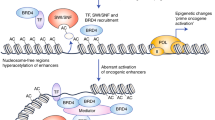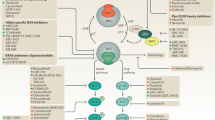Abstract
Myc is a pleiotropic basic helix–loop–helix leucine zipper transcription factor that coordinates expression of the diverse intracellular and extracellular programs that together are necessary for growth and expansion of somatic cells1. In principle, this makes inhibition of Myc an attractive pharmacological approach for treating diverse types of cancer. However, enthusiasm has been muted by lack of direct evidence that Myc inhibition would be therapeutically efficacious, concerns that it would induce serious side effects by inhibiting proliferation of normal tissues, and practical difficulties in designing Myc inhibitory drugs. We have modelled genetically both the therapeutic impact and the side effects of systemic Myc inhibition in a preclinical mouse model of Ras-induced lung adenocarcinoma by reversible, systemic expression of a dominant-interfering Myc mutant. We show that Myc inhibition triggers rapid regression of incipient and established lung tumours, defining an unexpected role for endogenous Myc function in the maintenance of Ras-dependent tumours in vivo. Systemic Myc inhibition also exerts profound effects on normal regenerating tissues. However, these effects are well tolerated over extended periods and rapidly and completely reversible. Our data demonstrate the feasibility of targeting Myc, a common downstream conduit for many oncogenic signals, as an effective, efficient and tumour-specific cancer therapy.
This is a preview of subscription content, access via your institution
Access options
Subscribe to this journal
Receive 51 print issues and online access
$199.00 per year
only $3.90 per issue
Buy this article
- Purchase on Springer Link
- Instant access to full article PDF
Prices may be subject to local taxes which are calculated during checkout




Similar content being viewed by others
References
Oster, S. K., Ho, C. S., Soucie, E. L. & Penn, L. Z. The myc oncogene: MarvelouslY Complex. Adv. Cancer Res. 84, 81–154 (2002)
Arvanitis, C. & Felsher, D. W. Conditionally MYC: insights from novel transgenic models. Cancer Lett. 226, 95–99 (2005)
Felsher, D. W. & Bishop, J. M. Reversible tumorigenesis by MYC in hematopoietic lineages. Mol. Cell 4, 199–207 (1999)
Flores, I. et al. Defining the temporal requirements for Myc in the progression and maintenance of skin neoplasia. Oncogene 23, 5923–5930 (2004)
Jain, M. et al. Sustained loss of a neoplastic phenotype by brief inactivation of MYC. Science 297, 102–104 (2002)
Pelengaris, S., Khan, M. & Evan, G. I. Suppression of Myc-induced apoptosis in beta cells exposes multiple oncogenic properties of Myc and triggers carcinogenic progression. Cell 109, 321–334 (2002)
Pelengaris, S. et al. Reversible activation of c-Myc in skin: induction of a complex neoplastic phenotype by a single oncogenic lesion. Mol. Cell 3, 565–577 (1999)
Amati, B., Littlewood, T. D., Evan, G. I. & Land, H. The c-Myc protein induces cell cycle progression and apoptosis through dimerization with Max. EMBO J. 12, 5083–5087 (1993)
Ferre-D’Amare, A. R., Prendergast, G. C., Ziff, E. B. & Burley, S. K. Recognition by Max of its cognate DNA through a dimeric b/HLH/Z domain. Nature 363, 38–45 (1993)
Nair, S. K. & Burley, S. K. Structural aspects of interactions within the Myc/Max/Mad network. Curr. Top. Microbiol. Immunol. 302, 123–143 (2006)
Amati, B. et al. Oncogenic activity of the c-Myc protein requires dimerisation with Max. Cell 72, 233–245 (1993)
Chen, J. et al. Effects of the MYC oncogene antagonist, MAD, on proliferation, cell cycling and the malignant phenotype of human brain tumour cells. Nature Med. 1, 638–643 (1995)
Prochownik, E. V. c-Myc as a therapeutic target in cancer. Expert Rev. Anticancer Ther. 4, 289–302 (2004)
Soucek, L. et al. Design and properties of a Myc derivative that efficiently homodimerizes. Oncogene 17, 2463–2472 (1998)
Soucek, L. et al. Omomyc, a potential Myc dominant negative, enhances Myc-induced apoptosis. Cancer Res. 62, 3507–3510 (2002)
Soucek, L., Nasi, S. & Evan, G. I. Omomyc expression in skin prevents Myc-induced papillomatosis. Cell Death Differ. 11, 1038–1045 (2004)
Baskar, J. F. et al. The enhancer domain of the human cytomegalovirus major immediate-early promoter determines cell type-specific expression in transgenic mice. J. Virol. 70, 3207–3214 (1996)
Furth, P. A. et al. The variability in activity of the universally expressed human cytomegalovirus immediate early gene 1 enhancer/promoter in transgenic mice. Nucleic Acids Res. 19, 6205–6208 (1991)
Kothary, R. et al. Unusual cell specific expression of a major human cytomegalovirus immediate early gene promoter-lacZ hybrid gene in transgenic mouse embryos. Mech. Dev. 35, 25–31 (1991)
Zhan, Y., Brady, J. L., Johnston, A. M. & Lew, A. M. Predominant transgene expression in exocrine pancreas directed by the CMV promoter. DNA Cell Biol. 19, 639–645 (2000)
Jackson, E. L. et al. The differential effects of mutant p53 alleles on advanced murine lung cancer. Cancer Res. 65, 10280–10288 (2005)
Jackson, E. L. et al. Analysis of lung tumor initiation and progression using conditional expression of oncogenic K-ras. Genes Dev. 15, 3243–3248 (2001)
Sweet-Cordero, A. et al. An oncogenic KRAS2 expression signature identified by cross-species gene-expression analysis. Nature Genet. 37, 48–55 (2005)
Okabe, M. et al. ‘Green mice’ as a source of ubiquitous green cells. FEBS Lett. 407, 313–319 (1997)
Sarin, K. Y. et al. Conditional telomerase induction causes proliferation of hair follicle stem cells. Nature 436, 1048–1052 (2005)
Sawamura, D. et al. Promoter/enhancer cassettes for keratinocyte gene therapy. J. Invest. Dermatol. 112, 828–830 (1999)
Wright, D. E. et al. Cyclophosphamide/granulocyte colony-stimulating factor causes selective mobilization of bone marrow hematopoietic stem cells into the blood after M phase of the cell cycle. Blood 97, 2278–2285 (2001)
Korinek, V. et al. Depletion of epithelial stem-cell compartments in the small intestine of mice lacking Tcf-4. Nature Genet. 19, 379–383 (1998)
Murphy, M. J., Wilson, A. & Trumpp, A. More than just proliferation: Myc function in stem cells. Trends Cell Biol. 15, 128–137 (2005)
Evan, G. I. Can’t kick that oncogene habit. Cancer Cell 10, 345–347 (2006)
Acknowledgements
We thank T. Jacks and S. Artandi for their gifts of LSL-KrasG12D and β-actin-rtTA+ mice, respectively. We thank F. Rostker for technical assistance and Y. Yaron and L. Johnson for advice on the LSL-KrasG12D model and adenovirus inhalation. We thank our laboratory colleagues for their comments and feedback. This study was supported by grant 2R01 CA98018 from the National Cancer Institute (to G.I.E.). S.N. acknowledges support from AIRC, ASI, CNR, MIUR FIRB and FIRS. C.P.M. is a Leukemia and Lymphoma Society Fellow. J.W. acknowledges support from Human Frontier Science Program. This paper is dedicated to the memory of Judah Folkman.
Author information
Authors and Affiliations
Corresponding author
Supplementary information
Supplementary Information
The file contains Supplementary Figures and Legends 1-4; Supplementary Tables 1-3. Supplementary Figure 1 represents quantitation of Omomyc and c-Myc expression in mouse tissues; Supplementary Figure 2 shows no influence of long-term systemic Omomyc expression on mouse weight; Supplementary. Figure 3 demonstrates that systemic Omomyc expression suppresses hair re-growth; Supplementary Figure 4 shows that induction of Omomyc in TRE-Omomyc; β-actin-rtTA mice recapitulates the intestinal and skin phenotypes of Doxycylin treated TREOmomyc;CMVrtTA mice and, additionally, elicits increased extramedullary hematopoiesis in spleen. Supplementary Table 1 shows that long-term systemic Omomyc expression has no significant impact on blood chemistry; Supplementary Table 2 includes blood counts showing that Omomyc expression causes transient anemia; Supplementary Table 3 includes detailed list of number and genotype of mice used for the experiments. (PDF 14691 kb)
Rights and permissions
About this article
Cite this article
Soucek, L., Whitfield, J., Martins, C. et al. Modelling Myc inhibition as a cancer therapy. Nature 455, 679–683 (2008). https://doi.org/10.1038/nature07260
Received:
Accepted:
Published:
Issue Date:
DOI: https://doi.org/10.1038/nature07260
This article is cited by
-
USP43 stabilizes c-Myc to promote glycolysis and metastasis in bladder cancer
Cell Death & Disease (2024)
-
Mechanism-centric regulatory network identifies NME2 and MYC programs as markers of Enzalutamide resistance in CRPC
Nature Communications (2024)
-
Genetically-engineered mouse models of small cell lung cancer: the next generation
Oncogene (2024)
-
Integrative bioinformatics analysis of WDHD1: a potential biomarker for pan-cancer prognosis, diagnosis, and immunotherapy
World Journal of Surgical Oncology (2023)
-
LncRNA BCAN-AS1 stabilizes c-Myc via N6-methyladenosine-mediated binding with SNIP1 to promote pancreatic cancer
Cell Death & Differentiation (2023)
Comments
By submitting a comment you agree to abide by our Terms and Community Guidelines. If you find something abusive or that does not comply with our terms or guidelines please flag it as inappropriate.



